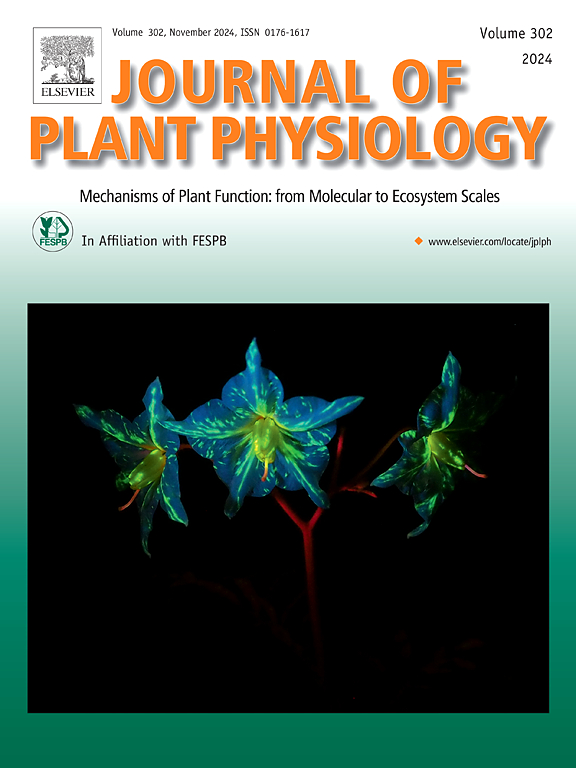The protein kinase MLOP1 mediates pectin fragment signaling and feedback regulation of cell wall synthesis
IF 4.1
3区 生物学
Q1 PLANT SCIENCES
引用次数: 0
Abstract
Plants sense the breakdown products of cell wall components to trigger effective stress responses and to adjust wall synthesis during development. Oligogalacturonides (OGs), derived from pectin degradation, are known to serve as signals for cell wall remodeling and stress responses, while little is known about their perception by plant cells. Here, we characterized a malectin-like domain-containing leucine-rich repeat receptor-like protein kinase MLOP1, which is involved in pectin fragment signal sensing in Arabidopsis thaliana. Mutations of MLOP1 impaired cell wall synthesis and cell elongation in seedling hypocotyls and primary roots. MLOP1 and its homologs were tandem duplicated during evolution. It is expressed in the rapid-growth region of hypocotyl, root elongation zone, leaf and stem vasculature, and silique. MLOP1-GFP is localized to the plasma membrane. The MLOP1 ectodomain is capable to bind with pectic polysaccharide in vitro, and the kinase domain may mediate intracellular signal transduction. Tests on mlop1 mutants indicate its involvement in OG-induced cell defense responses, including phytoalexin synthesis, nitric oxide (NO) accumulation, callose deposition and cytosolic Ca2+ spike. Accordingly, mlop1 mutants showed a high susceptibility to Pseudomonas syringae infection. Furthermore, loss of MLOP1 function alleviated OG-induced inhibition of cellulose synthase complex (CSC) mobility and its density on the plasma membrane. These results indicate that MLOP1 plays a role in pectin fragment signaling and mediates their effects on stress responses and cell wall remodeling.
蛋白激酶MLOP1介导果胶片段信号传导和细胞壁合成的反馈调节。
植物通过感知细胞壁成分的分解产物来触发有效的应激反应,并在发育过程中调节细胞壁的合成。低聚半乳糖醛酸脂(Oligogalacturonides, OGs)是由果胶降解而来,作为细胞壁重塑和应激反应的信号,但对植物细胞对其的感知知之甚少。在这里,我们鉴定了一个含有富含亮氨酸的重复受体样蛋白激酶MLOP1,它参与了拟南芥中果胶片段信号的感知。MLOP1突变破坏了幼苗下胚轴和初生根的细胞壁合成和细胞伸长。MLOP1及其同源物在进化过程中串联复制。它表达于下胚轴的快速生长区、根伸长区、叶和茎的维管系统以及角质层。MLOP1-GFP定位于质膜。MLOP1外结构域在体外能够与果胶多糖结合,激酶结构域可能介导细胞内信号转导。对mlop1突变体的测试表明,它参与og诱导的细胞防御反应,包括植物抗毒素合成、一氧化氮(NO)积累、胼胝质沉积和细胞质Ca2+峰值。因此,mlop1突变体对丁香假单胞菌感染表现出高易感性。此外,MLOP1功能的丧失减轻了og诱导的纤维素合酶复合物(CSC)迁移率及其在质膜上密度的抑制。这些结果表明MLOP1在果胶片段信号传导中发挥作用,并介导其对应激反应和细胞壁重塑的影响。
本文章由计算机程序翻译,如有差异,请以英文原文为准。
求助全文
约1分钟内获得全文
求助全文
来源期刊

Journal of plant physiology
生物-植物科学
CiteScore
7.20
自引率
4.70%
发文量
196
审稿时长
32 days
期刊介绍:
The Journal of Plant Physiology is a broad-spectrum journal that welcomes high-quality submissions in all major areas of plant physiology, including plant biochemistry, functional biotechnology, computational and synthetic plant biology, growth and development, photosynthesis and respiration, transport and translocation, plant-microbe interactions, biotic and abiotic stress. Studies are welcome at all levels of integration ranging from molecules and cells to organisms and their environments and are expected to use state-of-the-art methodologies. Pure gene expression studies are not within the focus of our journal. To be considered for publication, papers must significantly contribute to the mechanistic understanding of physiological processes, and not be merely descriptive, or confirmatory of previous results. We encourage the submission of papers that explore the physiology of non-model as well as accepted model species and those that bridge basic and applied research. For instance, studies on agricultural plants that show new physiological mechanisms to improve agricultural efficiency are welcome. Studies performed under uncontrolled situations (e.g. field conditions) not providing mechanistic insight will not be considered for publication.
The Journal of Plant Physiology publishes several types of articles: Original Research Articles, Reviews, Perspectives Articles, and Short Communications. Reviews and Perspectives will be solicited by the Editors; unsolicited reviews are also welcome but only from authors with a strong track record in the field of the review. Original research papers comprise the majority of published contributions.
 求助内容:
求助内容: 应助结果提醒方式:
应助结果提醒方式:


